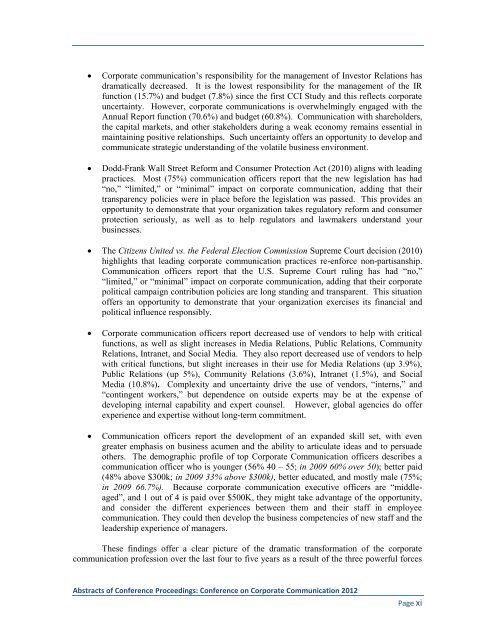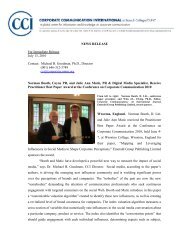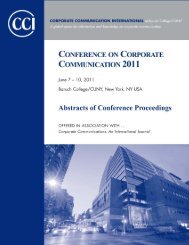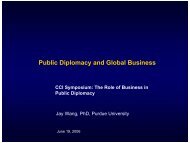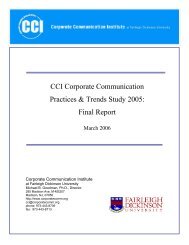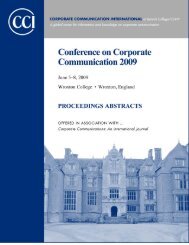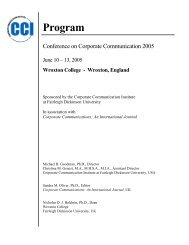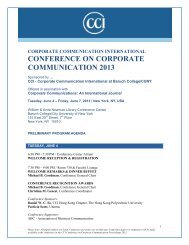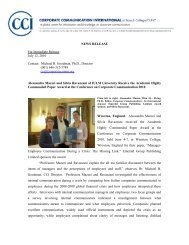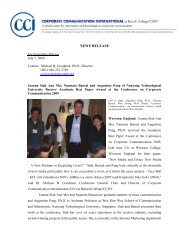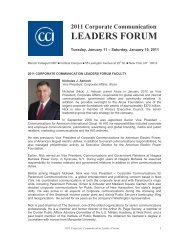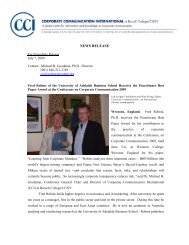Proceedings: Conference on Corporate Communication 2012 Page 1
Proceedings: Conference on Corporate Communication 2012 Page 1
Proceedings: Conference on Corporate Communication 2012 Page 1
You also want an ePaper? Increase the reach of your titles
YUMPU automatically turns print PDFs into web optimized ePapers that Google loves.
<strong>Corporate</strong> communicati<strong>on</strong>’s resp<strong>on</strong>sibility for the management of Investor Relati<strong>on</strong>s has<br />
dramatically decreased. It is the lowest resp<strong>on</strong>sibility for the management of the IR<br />
functi<strong>on</strong> (15.7%) and budget (7.8%) since the first CCI Study and this reflects corporate<br />
uncertainty. However, corporate communicati<strong>on</strong>s is overwhelmingly engaged with the<br />
Annual Report functi<strong>on</strong> (70.6%) and budget (60.8%). Communicati<strong>on</strong> with shareholders,<br />
the capital markets, and other stakeholders during a weak ec<strong>on</strong>omy remains essential in<br />
maintaining positive relati<strong>on</strong>ships. Such uncertainty offers an opportunity to develop and<br />
communicate strategic understanding of the volatile business envir<strong>on</strong>ment.<br />
Dodd-Frank Wall Street Reform and C<strong>on</strong>sumer Protecti<strong>on</strong> Act (2010) aligns with leading<br />
practices. Most (75%) communicati<strong>on</strong> officers report that the new legislati<strong>on</strong> has had<br />
“no,” “limited,” or “minimal” impact <strong>on</strong> corporate communicati<strong>on</strong>, adding that their<br />
transparency policies were in place before the legislati<strong>on</strong> was passed. This provides an<br />
opportunity to dem<strong>on</strong>strate that your organizati<strong>on</strong> takes regulatory reform and c<strong>on</strong>sumer<br />
protecti<strong>on</strong> seriously, as well as to help regulators and lawmakers understand your<br />
businesses.<br />
The Citizens United vs. the Federal Electi<strong>on</strong> Commissi<strong>on</strong> Supreme Court decisi<strong>on</strong> (2010)<br />
highlights that leading corporate communicati<strong>on</strong> practices re-enforce n<strong>on</strong>-partisanship.<br />
Communicati<strong>on</strong> officers report that the U.S. Supreme Court ruling has had “no,”<br />
“limited,” or “minimal” impact <strong>on</strong> corporate communicati<strong>on</strong>, adding that their corporate<br />
political campaign c<strong>on</strong>tributi<strong>on</strong> policies are l<strong>on</strong>g standing and transparent. This situati<strong>on</strong><br />
offers an opportunity to dem<strong>on</strong>strate that your organizati<strong>on</strong> exercises its financial and<br />
political influence resp<strong>on</strong>sibly.<br />
<br />
<br />
<strong>Corporate</strong> communicati<strong>on</strong> officers report decreased use of vendors to help with critical<br />
functi<strong>on</strong>s, as well as slight increases in Media Relati<strong>on</strong>s, Public Relati<strong>on</strong>s, Community<br />
Relati<strong>on</strong>s, Intranet, and Social Media. They also report decreased use of vendors to help<br />
with critical functi<strong>on</strong>s, but slight increases in their use for Media Relati<strong>on</strong>s (up 3.9%),<br />
Public Relati<strong>on</strong>s (up 5%), Community Relati<strong>on</strong>s (3.6%), Intranet (1.5%), and Social<br />
Media (10.8%). Complexity and uncertainty drive the use of vendors, “interns,” and<br />
“c<strong>on</strong>tingent workers,” but dependence <strong>on</strong> outside experts may be at the expense of<br />
developing internal capability and expert counsel. However, global agencies do offer<br />
experience and expertise without l<strong>on</strong>g-term commitment.<br />
Communicati<strong>on</strong> officers report the development of an expanded skill set, with even<br />
greater emphasis <strong>on</strong> business acumen and the ability to articulate ideas and to persuade<br />
others. The demographic profile of top <strong>Corporate</strong> Communicati<strong>on</strong> officers describes a<br />
communicati<strong>on</strong> officer who is younger (56% 40 – 55; in 2009 60% over 50); better paid<br />
(48% above $300k; in 2009 33% above $300k), better educated, and mostly male (75%;<br />
in 2009 66.7%). Because corporate communicati<strong>on</strong> executive officers are “middleaged”,<br />
and 1 out of 4 is paid over $500K, they might take advantage of the opportunity,<br />
and c<strong>on</strong>sider the different experiences between them and their staff in employee<br />
communicati<strong>on</strong>. They could then develop the business competencies of new staff and the<br />
leadership experience of managers.<br />
These findings offer a clear picture of the dramatic transformati<strong>on</strong> of the corporate<br />
communicati<strong>on</strong> professi<strong>on</strong> over the last four to five years as a result of the three powerful forces<br />
Abstracts of <str<strong>on</strong>g>C<strong>on</strong>ference</str<strong>on</strong>g> <str<strong>on</strong>g>Proceedings</str<strong>on</strong>g>: <str<strong>on</strong>g>C<strong>on</strong>ference</str<strong>on</strong>g> <strong>on</strong> <strong>Corporate</strong> Communicati<strong>on</strong> <strong>2012</strong><br />
<strong>Page</strong> xi


